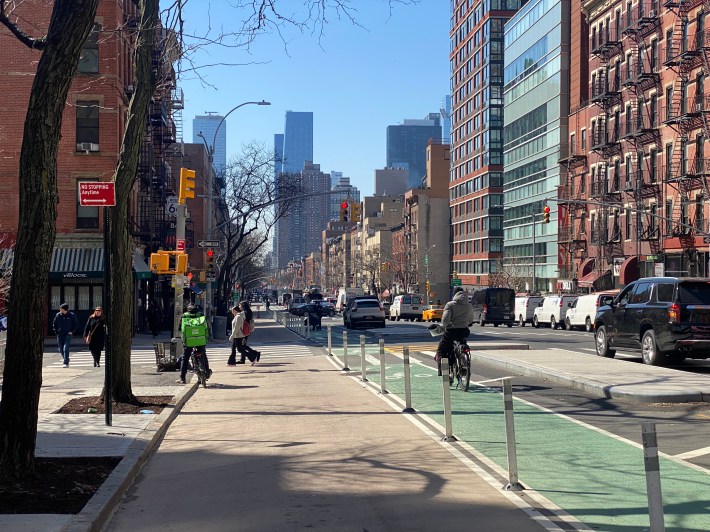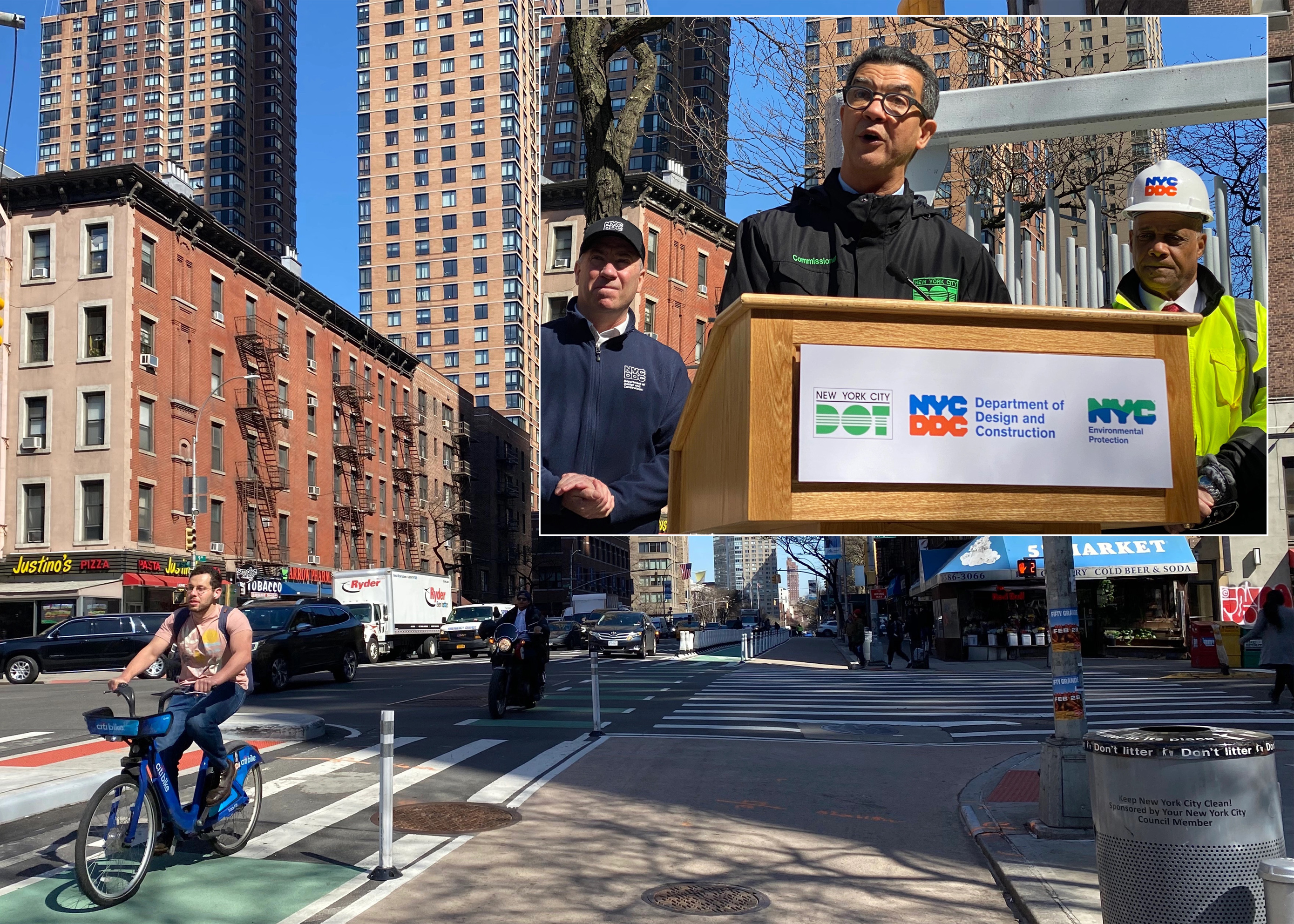A recently completed, decade-long overhaul of the sewers and water mains on Ninth Avenue in Manhattan gave city officials the opportunity to expand pedestrian space along the strip — a design feature the Department of Transportation on Tuesday pledged to roll out to other parts of the city.
The painted sidewalk extensions between 50th and 59th streets — a longtime feature of the agency toolkit that officials have rebranded "super sidewalks" — follow similar redesigns on nearby Eighth and Seventh avenues, and Commissioner Ydanis Rodriguez said that the renovation will become a key tool to reclaim more space for people across the city.
"While we are excited to bring this improvement to Hells Kitchen, we look forward to expanding these efforts elsewhere to create a better city to live, work, and play," Rodriguez told reporters at Tuesday's presser/ribbon-cutting.
The Ninth Avenue redesign — the final step of a $231-million project led by the departments of Environmental Protection and of Design and Construction — removed one of four southbound car lanes and replaced it with 11 feet of beige-painted pedestrian space on the east curb along side the existing 15-foot sidewalk. The street already had a parking-protected bike lane and concrete pedestrian islands that DOT moved over to accommodate the changes.

More is in store for the area. The city also plans to add super sidewalks this year on Ninth Avenue between W. 30th and W. 34th streets, officials said. That project will include painted extensions as well as concrete pedestrian islands and a concrete curb extension outside Moynihan Train Hall between W. 31st Street and W. 33rd streets.
Locals praised DOT for giving more room to the crowds of Midtown pedestrians that can be at times unbearable, or worse, impassable. The redesign removes car space in an area where 85 percent of households don't own one, despite the fourth-highest traffic volume in the city.
"It’s just like having air to breathe," said Christine Berthet, who founded the pedestrian advocacy group CHEKPEDS and is a co-chair of the Manhattan Community Board 4 Transportation Committee.
The avenue's narrow sidewalks dated back to the age of master builder Robert Moses, who trimmed them to make room for more cars heading to and from the Lincoln Tunnel, Berthet said. DOT was able to take advantage of DEP and DDC tearing up the street to do its revamp — a smart way to get more bang out of the utility work buck, according to one urban planner.
"That’s just an obvious way to get things done efficiently and take that opportunity to expand the quality of the public realm," said Mike Lydon of the planning firm Street Plans.
The city could have used the chance to expand concrete sidewalks, too, Lydon said. That would have allowed for other permanent improvements like street trees and rain gardens, while also discouraging drivers from parking illegally in the new pedestrian spaces.
"It’s quick and it’s cheap and it gets the job done, but it also it has limitations," he said. "You’re spending all that money on the sub-surface infrastructure … adding actual curb and concrete expansions to the sidewalk, [it] would be a big opportunity to do that as well."
DOT did not say why it did not add more concrete, but DDC normally budgets only enough to rebuild the same type of street, without funds to pour additional cement, Berthet said. Using cheaper paint for the "super sidewalks" allows DOT to cover more space.
"Normally when DDC does a job their contract with the city is to restore the street in the way it was before," Berthet said. "Because before it was a normal sidewalk, they wouldn’t have had any budget to do something different."

Of course, the paint also allows drivers to intrude on the pedestrian space. CB4 members have previously asked DOT to address drivers — including from the NYPD — who hog the beige "super sidewalks" on Eighth Avenue.
Asked about the issue Tuesday, Rodriguez said pedestrian areas are "sacred spaces," adding that his agency will work with NYPD to curb their law-flouting behavior.
"We’re working with some of the local precincts to address any challenges that we may have," he said.
DOT also plans to install a parking-protected bike lane on nearly 40 blocks of 10th Avenue, following calls by area Council member Erik Bottcher, who demanded they narrow both that highway-like roadway and adjacent 11th Avenue tearing through the increasingly-residential West Side neighborhoods.
Officials declined to comment on whether they have any plans for 11th Avenue.






